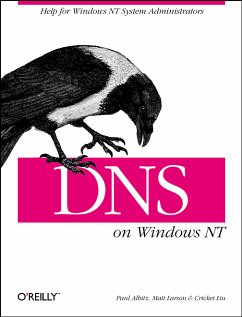DNS on Windows NT is a special edition of the classic DNS and BIND, which Microsoft recommends for Windows NT users and administrators. It discusses one of the Internet's fundamental building blocks: the distributed host information database that's responsible for translating names into addresses, routing mail to its proper destination, and many other services. As the authors write in the preface, if you're using the Internet, you're already using DNS -- even if you don't know it.
This book covers the DNS server in Windows NT 4.0, as updated with Service Pack 3. In addition to covering general issues, like installing, setting up, and maintaining the server, it covers many issues specific to the Windows environment: integration between DNS and WINS, converting from BIND to the Microsoft DNS server, and registry settings. It pays special attention to security issues, system tuning, caching, and zone change notification. It also pays detailed attention to issues like troubleshooting and planning for growth.
Whether you're an administrator involved with DNS on a daily basis, or a user who wants to be more informed about the Internet and how it works, you'll find that this book is essential reading.
Topics include:
* What DNS does, how it works, and when you need to use it
* How to find your own place in the Internet's name space
* Setting up name servers
* Using MX records to route mail
* Configuring hosts to use DNS name servers
* Subdividing domains (parenting)
* Securing your name server: preventing unauthorized zone transfers
* Mapping one name to several servers for load sharing
* Troubleshooting: using nslookup, diagnosing common problems
This book covers the DNS server in Windows NT 4.0, as updated with Service Pack 3. In addition to covering general issues, like installing, setting up, and maintaining the server, it covers many issues specific to the Windows environment: integration between DNS and WINS, converting from BIND to the Microsoft DNS server, and registry settings. It pays special attention to security issues, system tuning, caching, and zone change notification. It also pays detailed attention to issues like troubleshooting and planning for growth.
Whether you're an administrator involved with DNS on a daily basis, or a user who wants to be more informed about the Internet and how it works, you'll find that this book is essential reading.
Topics include:
* What DNS does, how it works, and when you need to use it
* How to find your own place in the Internet's name space
* Setting up name servers
* Using MX records to route mail
* Configuring hosts to use DNS name servers
* Subdividing domains (parenting)
* Securing your name server: preventing unauthorized zone transfers
* Mapping one name to several servers for load sharing
* Troubleshooting: using nslookup, diagnosing common problems

